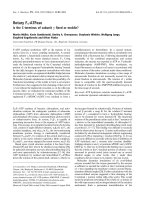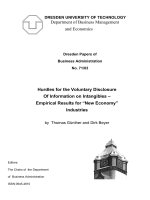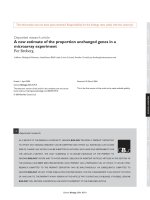Assignment about Trade
Bạn đang xem bản rút gọn của tài liệu. Xem và tải ngay bản đầy đủ của tài liệu tại đây (206.04 KB, 13 trang )
Unit 9: Trade
FOREIGN TRADE UNIVERSITY
FACULTY OF BUSINESS ADMINISTRATION
Assignment:
TRADE
Intructor: MS. ….
Group 2 :
1. Nguyễn Thị Hồng vân
2. Nguyễn Nga Hằng
3. Nguyễn Thị Thu Hiền
4. Phạm Thị Lan Hương
Class : A2 – K46
Major: International Business
Hanoi, 18
th
, January, 2010
Introduction
1
Unit 9: Trade
Trade is the voluntary exchange of goods, services, or both of which also
called commerce or transaction. Evidently, this topic is familiar to almost
everyone, in particular students of economics major.
To mention about trade, we can point out a lot of subtopics related such as
modern trends of trade, benefits and drawbacks of trade, and so on. In this Market
leader course book, the authors cover almost featured knowledge about trade in the
structure of 5 parts
I. Start up with discussion about globalization
II. Vocabulary related to “ trade”
III. Reading: Fair trade
IV. Language skills for negotiation of a business deal
V. Case study about negotiation
Our group has spent much time researching this topic and now presents here
the most remarkable information which is certainly useful for you.
Please let us know if there are any problems with our assignment.
2
Unit 9: Trade
I. STARTING UP - GLOBALIZATION
Globalization is a process of interaction and integration among the people,
companies, and governments of different nations, a process driven by international
trade and investment and aided by information technology. This process has effects
on the environment, on culture, on political systems, on economic development
and prosperity, and on human physical well-being in societies around the world.
Globalization is not new, though. For thousands of years, people - and, later,
corporations - have been buying from and selling to each other in lands at great
distances, such as through the famed Silk Road across Central Asia that connected
China and Europe during the Middle Ages. Likewise, for centuries, people and
corporations have invested in enterprises in other countries. In fact, many of the
features of the current wave of globalization are similar to those prevailing before
the outbreak of the First World War in 1914.
This current wave of globalization has been driven by policies that have
opened economies domestically and internationally. In the years since the Second
World War, and especially during the past two decades, many governments have
adopted free-market economic systems, vastly increasing their own productive
potential and creating myriad new opportunities for international trade and
investment. Governments also have negotiated dramatic reductions in barriers to
commerce and have established international agreements to promote trade in
goods, services, and investment. Taking advantage of new opportunities in foreign
markets, corporations have built foreign factories and established production and
marketing arrangements with foreign partners. A defining feature of globalization,
therefore, is an international industrial and financial business structure. Moreover,
the survival in the new global business market calls for improved productivity and
3
Unit 9: Trade
increased competition. Due to the market becoming worldwide, companies in
various industries have to upgrade their products and use technology skillfully in
order to face increased competition.
Technology has been the other principal driver of globalization. Advances in
information technology, in particular, have dramatically transformed economic
life. Information technologies have given all sorts of individual economic actors -
consumers, investors, businesses - valuable new tools for identifying and pursuing
economic opportunities, including faster and more informed analyses of economic
trends around the world, easy transfers of assets, and collaboration with far-flung
partners.
Globalization is deeply controversial, however. Proponents of globalization
argue that it allows poor countries and their citizens to develop economically and
raise their standards of living, while opponents of globalization claim that the
creation of an unfettered international free market has benefited multinational
corporations in the Western world at the expense of local enterprises, local
cultures, and common people. Resistance to globalization has therefore taken
shape both at a popular and at a governmental level as people and governments try
to manage the flow of capital, labor, goods, and ideas that constitute the current
wave of globalization.
To find the right balance between benefits and costs associated with
globalization, citizens of all nations need to understand how globalization works
and the policy choices facing them and their societies.
4
Unit 9: Trade
II . VOCABULARIES
5
Unit 9: Trade
6
Vocabularies Explaination Structure and idioms Example
English Vienamese
Global
['gloubəl]
involving the
entire earth; not
limited or
provincial in scope
Toàn cầu global strategy :
chiến lược toàn cầu
Many
people wish
they could
have a
global tour.
Tax
[tæks]
A charge,
especially a
pecuniary burden
which is imposed
by authority
Thuế + sales tax: thuế
doanh thu
+ to levy a tax on
something:đánh thuế
vào cái gì
The car tax
in VN is
very high
Liberalise
[‘libərəlaiz]
to free from
narrow views or
prejudices; to
make less strict
Mở rộng tự
do
There is a
move to
liberalise
economy.
Barrier
['bæriə]
an object like a
fence that prevents
people from
moving forward
from one place to
another
hàng rào + to barrier the way:
chặn đường
+ to barrier in: cản
không cho vào
+ to barrier out: cản
không cho ra
We must try
our best to
break the
tax barrier.
Border
['bɔ:də]
A boundary; a
frontier of a state
or of the settled
part of a country
biên giới
Ural is
considered
the natural
border
bettwen the
Asia and the
Europe .
Custom
['tærif]
The taxes that must
be paid to the
government when
goods are brought
in from other
countries
Thuế nhập
khẩu; hải
quan
+ preferential
tariff:quan thuế ưu
đãi
+ to raise tariff
barriers:
lập hàng rào quan
thuế
We must
raise tarriff
barriers
agaist
foreign
goods.
Subsidize
['sʌbsidaiz]
to aid or promote,
as a private
enterprise, with
public money
Trợ cấp subsidized
industries: các ngành
công nghiệp được
bao cấp
In our
country,
there have
many
Unit 9: Trade
III. READING
A. Before reading:
1. What is Fair Trade?
Fair Trade is an organized social movement and market-based approach that
aims to help producers in developing countries and promote sustainability. The
movement advocates the payment of a higher price to producers as well as social
and environmental standards. It focuses in particular on exports from developing
countries to developed countries, most notably handicrafts, coffee, cocoa, sugar,
tea, bananas, honey, cotton, wine, fresh fruit, chocolate and flowers.
2. Traditional export products of some countries:
Bananas 1. India, Ecuador
Coffee 2. Brazil
Sugar 3. Brazil
• India Produces Most Bananas but Ecuador is King of Banana Exports
( )
3. Typical problems which the exporters face when selling aboard:
- The protection of the government for domestic market (quota, tax, barrier )
- Domestic competitors
- Not good understanding of consumption habits
B. Reading: UK develops taste for fair trade.
Summary: The banana and sugar cane growers are facing ruin and cannot break
into the European or US market because of high tariffs and heavy subsidies. But
the growing “fair trade” market can protect them from depressed world commodity
markets and the price war between giant multinationals. Fair trade, according to its
supporters, plays an important role in tackling the poverty. Now, fair trade food is
booming with the growth of more than 25% a year internationally and 100% a year
in Britain, the largest market after Switzerland. Trading fairly was designed to
reduce the injustices of the world trading system but ironically it could itself
become a victim of the WTO because its rules prohibits differentiation between the
products on the basis of their means of production. However, the fair trade shows
7
Unit 9: Trade
that charity is not needed to lift people out of poverty and that social and
environmental standards can be put into trade.
VI. USEFULL LANGUAGE AND SKILLS
This is the content of the meeting in which Ashbury company and KGC
negotiates about the conditions and term of the order. In this text , there are a
lot of necessary useful language and skills which seem quite popular in
negotiating.
The content of the meeting
Ashbury Company: Nice to meet you. Let me introduce about myself. My name
is Hien, the owner of Ashbury Guitars. And this is Ms Huong, our
marketing director.
KGC : Nice to meet you. I’m Hang, the Marketing Director and she is Ms Van,
the Director, from Kim guitar company
KGC : We come here to reach a deal with you today. After discussing through
email, we should make clear some main points. As you know, we agreed
to supply you 3 models: SG1000, SG500 and SG200. SG1000 has some
special additional features which satisfy your requirement.
Ashbury Company: Right, let’s talk more about the quality.
KGC :: We suggest 40% of the order to be manufactured by other Korean firms
Ashbury Company: Actually, I request you to produce all the guitars in your
own factory as I’m afraid that the quality of the goods are not guaranteed
if you use parts of other manufacturers.
KGC : But it seems difficult for us this time. We have to fulfill many other
customers since these products are in great demand. Maybe we think
about a lower percentage, say 20?
8
Unit 9: Trade
Ashbury Company: We are indeed not satisfactory at all. But we can accept this
percentage if all prices include transport costs to Pusan, Korea.
KGC : Sound a good idea to me.
Ashbury Company: What about discount? If we order 1800 units, what discount
will you offer?
KGC : On 1800, 3%. But if you place an order of at least 2000, we will offer you
a bit higher discount.
Ashbury Company: OK, I’ll think about that. If we place such a very large order,
say 2000, are you able to dispatch immediately?
KGC :: We can normally guarantee to dispatch a large order within 3 weeks. But
if you order at a peak time, like just before May, it will be impossible to
deliver that quickly.
Ashbury Company: To be honest, we hope that delivery will be made not later
than 1
st
May in time for the music festivals sales period in California.
KGC : We can understand that. I think the delivery made in 2 shipments, 50% on
1st May and remaining 50% on 15th May seems more suitable.
Ashbury Company: If you give us a 5% discount, we will agree that.
KGC: 5%? That’s more than we usually offer new customers. But it might be
possible .
Ashbury Company: That’s alright. Anyway, if you don’t deliver in time, we
won’t order from you again. And what about payment? I want to pay a
deposit of 50% immediately, remaining after 1 month after receiving
goods.
KGC: Frankly, we would prefer payment made by L/C, DP as this is our first
business. If you were a regular customer, we would offer you 30 days’
credit.
Ashbury Company: What do you mean?
KGC : As per the delivery condition, we would like you make the payment
immediately after each shipment.
Ashbury Company: Are you saying: 50% after the first shipment and 50% for
the last?
KGC: Exaclty what I mean.
9
Unit 9: Trade
Ashbury Company: That’s alright. We will make it by bank transfer as soon as
the goods have been dispatched.
Hằng : Good, we have agreed on price, quality, quantity, discount, delivery and
payment. Let’s see the guarantee.
Ashbury Company: We hope a guarantee of at least 3 years.
KGC : It’s OK. Great. We’ve got a deal. I’ll send you an email covering
everything agreed. Please let me know if there are any problems.
Ashbury Company: That’s good. Uhm…Look, it’s time for lunch. How about a
small party to congratulate on our good relationship today?
KGC : Great. It’s our honour.
Ashbury Company: Let’s go
* Note: The words which are highlighted are useful language in negotiation.
V. CASE STUDY
1. MINUTES
A. Context
- Date: 7
th
April, 2009
- Time: 9 A.m
- Place: Head office of Ashbury Guitars , San Francisco
B. Participants:
- Kim Guitar Company: Ms Van Nguyen – The Director, Ms Hang
Nguyen – the Marketing director
- Ashbury Company: Ms Hien Nguyen – The Director, Ms Huong Pham –
The Marketing Director
We can point out the terms and conditions agreed during negotiation as
follows:
1. Models:
SG 1000, SG 500, SG200
SG 1000: special additional features
2. Quality:
10
Unit 9: Trade
All the guitars with 20% manufactured by other Korean firms
3. Quantity:
First order:
- SG 1000: 500
- SG 500:1200,
- SG 200: 300
4. Prices:
- SG 1000: $920
- SG 500: $550
- SG200: $475
All the prices quoted CIF- Busan, Korea
5. Payment:
- By bank transfers
- Payment is made immediately after each shipment
6. Delivery:
- In two shipments:
The first : 50% each models on 1
st
June
The rest : on 15
th
June.
7. Discount:
- First order: 5%
- Further order: 7%
Hanoi, 7
th
April, 2009
Hang Nguyen
The Marketing director
2. COMMERCIAL CORRESPONDENCE
Dear Mr Kim,
We would like to thank you for your welcome last week and were very
pleased to point out some terms and conditions we have established. We can
confirm that there would certainly be no trouble in supplying you from our wide
range of guitars.
11
Unit 9: Trade
Enclosed you will find our price list of 3 models you have ordered quoting
prices CIF Pusan, Korea including transport costs. 20% units of the order will be
made by other Korean manufacturers to meet your need on time.
We do not normally give a quantity discount of 3% to new customers, but
because of our future long association, we can offer you 5% quantity discount off
net prices for order of 2000 units.
Delivery made in 2 shipments is a firm condition of this order. One shipment
is to be made by 1
st
May, and the other by 15
th
May, in time for Music festivals in
California.
As agreed, payment is to be made by an irrevocable letter of credit, which
we have already applied to the bank for. And we agreed that payment would be
made right after you have received our goods. In addition, we can offer you a
guarantee of 3 years
We hope your will be satisfied with our first order and look forward to many
further businesses.
Your sincerely,
Richard Gratt
(Signature)
Encs: price-list
12
Unit 9: Trade
Index
Introduction …………………… 1
I. Vocabularies …………………… 2
II. Starting up - Globalization …………………… 7
III. Reading – Fair trade
- What is fair trade?
- Reading
……………………
……………………
9
9
IV. Useful language and skills
- Negotiation …………………… 11
V. Case study
- Minutes
- Commercial correspondence
……………………
……………………
12
14
13









